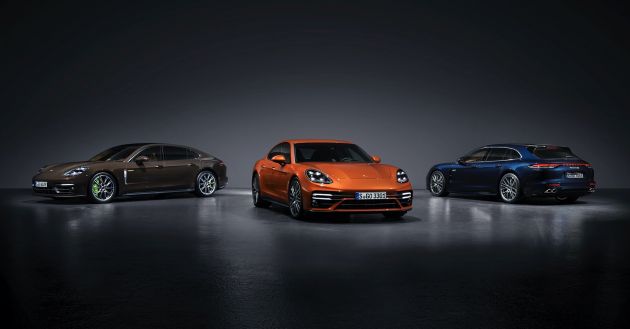2020 Porsche Panamera facelift – 630 PS/820 Nm Turbo S; PHEV 4S E-Hybrid with 54 km electric range
The second-generation Panamera facelift has made its debut, in three bodystyles – fastback sedan, Sport Turismo shooting brake and long-wheelbase Executive. The top of the Panamera range is now the Turbo S, which now produces 630 PS at 6,000 rpm and 820 Nm of torque between 2,300 rpm and 4,500 rpm.
This propels the fastback sedan bodystyle from a standstill to 100 km/h in 3.1 seconds, while 0-200 km/h is done in 11.2 seconds. The Turbo S Sport Turismo does the former in an identical 3.1 seconds, while the latter takes 0.3 second longer for the longer-roofed version at 11.5 seconds.
Meanwhile, the long-wheelbase Turbo S Executive takes fractionally longer over the 0-100 km/h run at 3.2 seconds, while its 0-200 km/h time is identical to the Sport Turismo’s at 11.5 seconds. Top speeds for all Turbo S bodystyles are identical, at 315 km/h.
Residing at the more accessible end of the Panamera spectrum is the base petrol V6 RWD model, which is offered solely in regular wheelbase fastback guise. This is powered by a 2,894 cc biturbo engine which produces 330 PS from 5,400 rpm to 6,400 rpm and 450 Nm of torque from 1,800 rpm to 5,000 rpm, and propels the base model from 0-100 km/h in 5.6 seconds, and 0-100 km/h in 21.6 seconds; top speed for the base RWD Panamera is 270 km/h.
Stepping up to all-wheel-drive for the same 2.9 litre engine gives the option of all three bodystyles. Meanwhile, the pre-facelift internal combustion Panamera 4S is now the PHEV 4S E-Hybrid, supplanting the previous petrol-only 440 PS/550 Nm 2.9 litre biturbo petrol V6 with electrification that brings pre-facelift Turbo variant levels of output, now offering 560 PS at 5,750–6,800 rpm and 750 Nm at 1,400–4,500 rpm.
The total system output from the Panamera 4S E-Hybrid comes courtesy of a 136 PS electric motor integrated into the standard eight-speed PDK dual-clutch transmission, mated with the 440 PS petrol biturbo V6. This draws electricity from a 17.9 kWh battery that offers a pure EV range of 54 km on the WLTP EAER City cycle. 0-100 km/h is attained in 3.7 seconds and 0-200 km/h in 1.36 seconds, and top speed for the 4S E-Hybrid is 298 km/h.
The Panamera GTS returns as the enthusiasts’ option in this facelifted range, featuring a biturbo petrol V8 of the same 3,996 cc displacement as its Turbo S sibling, albeit with a relatively modest 480 PS at 6,500 rpm and 620 Nm of torque at 1,800 – 4,000 rpm.
This equates to an increase of 20 PS over the outgoing, pre-facelift GTS with the same peak torque figure, and propels the fastback-bodied GTS from 0-100 km/h in 3.9 seconds and 0-200 km/h in 15.1 seconds with a top speed of 300 km/h, while the GTS Sport Turismo does 8 km/h less at the top end and 0.3 second slower to 100 km/h.
Particular attention has been paid to the GTS’ power delivery, says Porsche, which has been calibrated to increase in a more linear fashion with engine RPM, and ‘therefore like that of a classic sports car with a naturally aspirated engine’, said the manufacturer, in order for drivers to feel the increase in outputs even beyond 5,500 rpm.
The Panamera GTS gets a sport exhaust system as standard, which has been designed with an asymmetric layout in order to counter the further reduced exhaust noise produced by the V8 engine’s firing sequence, and enhances the engine layout’s characteristic sound as a result, says Porsche. The GTS’ sport exhaust system is also optionally available on the Panamera Turbo S.
Porsche Active Suspension Management is standard across the facelifted Panamera range, and this has been revamped to offer noticeably improved damping comfort, the German marque says. The Porsche Dynamic Chassis Control Sport (PDCC Sport) system offers active roll stabilisation, while PTV Plus torque vectoring is available on selected models.
Inside, the Panamera facelift receives Porsche’s latest steering wheel design as featured in the 992-generation 911 and the Taycan. Three seat variants are available for the latest Panamera, with an eight-way comfort seat being the standard offering.


A massage function is also available with the 14-way adjustable comfort seat, as well as for the eight-way adjustable rear comfort seats. Meanwhile, those looking for sportier option can choose the 18-way adjustable adaptive sport seat with raised side bolsters.
The long-wheelbase Executive bodystyle can be optioned with a large, rear centre console which offers extra storage space, another smartphone tray, two USB charging interfaces, a USB media interface along with a 12-volt and 230-volt power socket. Folding tables are also available for the rear seats in the Executive.
Audio in the Panamera Turbo S features a 14-speaker, 710-watt Bose Surround Sound system as standard, and this includes a subwoofer. Those wanting an even higher specification of audio can opt for the 21-speaker Burmester High-End Surround system with 400-watt subwoofer, with total output rated at 1,455 watts. Device connectivity has been updated from USB Type A to Type C, which can now charge compatible devices at up to 15 watts.
The Porsche Communication Management system adds digital functions and services for the facelifted Panamera, such as improved Voice Pilot voice command and Risk Radar for up-to-date road signage and hazard information, along with wireless Apple CarPlay and updated Porsche Connect services.
Driver assistance functions now feature lane keeping assist as standard with road sign recognition, adaptive cruise control, night vision assist, lane change assist, Park Assist with Surround View and head-up display. Lighting equipment includes LED matrix headlights with PDLS Plus.
Order books have opened for the facelifted, second-gen Porsche Panamera in Germany, which starts from 91,345 euros (RM450,879) for the base RWD Panamera, while the AWD Panamera 4 starts from 95,289 euros (RM470,347). The PHEV 4S E-Hybrid start from 126,841 euros (RM626,088) while the Panamera GTS begins from 136,933 euros (RM675,902), and the Turbo S kicks off from 179,737 euros (RM887,183).















The post 2020 Porsche Panamera facelift – 630 PS/820 Nm Turbo S; PHEV 4S E-Hybrid with 54 km electric range appeared first on Paul Tan's Automotive News.
from Paul Tan's Automotive News
Read The Rest:paultan...








Post a Comment